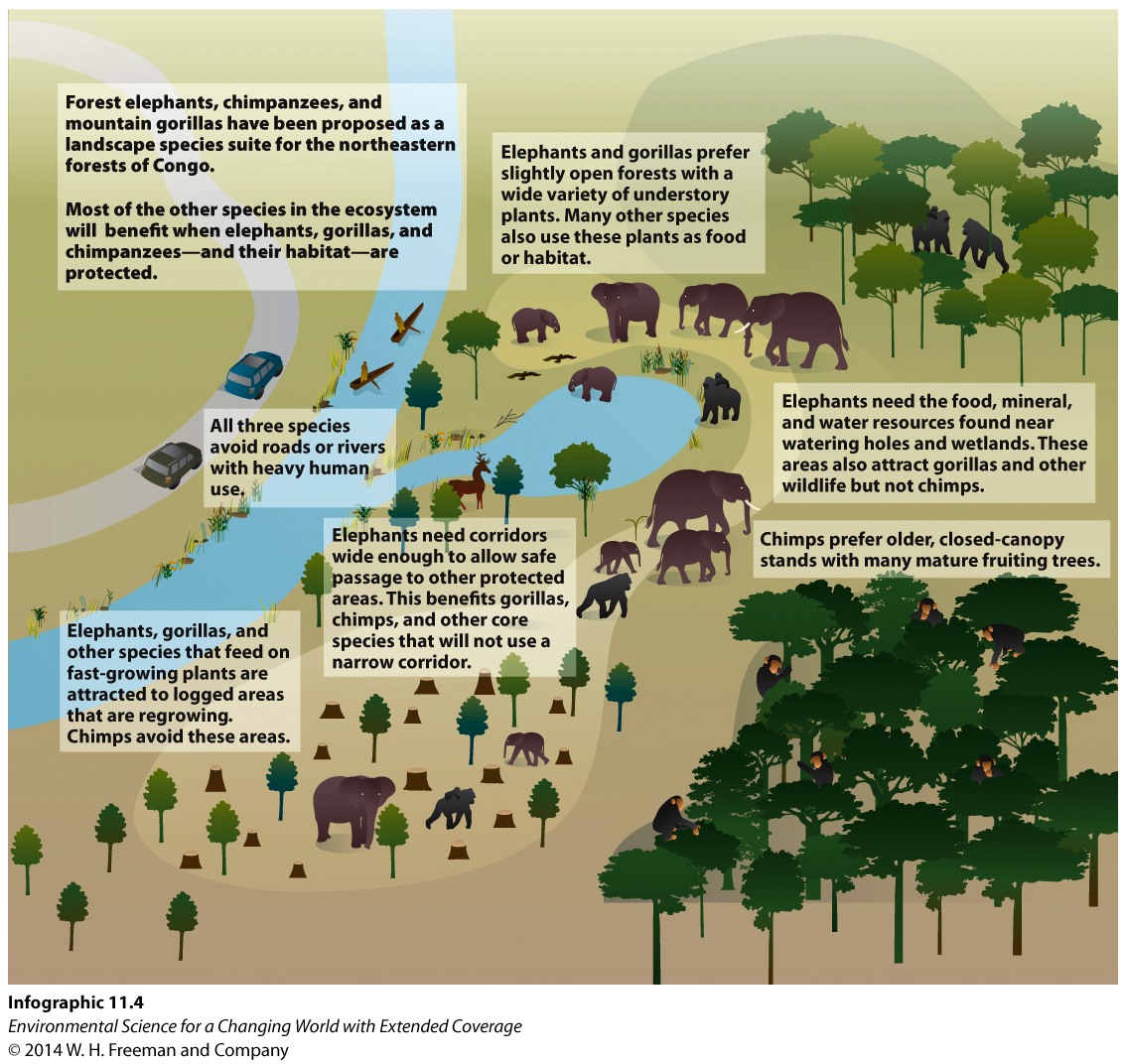Chapter 11. Chapter 11: Preserving Biodiversity
How do single species conservation programs compare to ecosystem-based approaches?

Guiding Question 11.2
How do single species conservation programs compare to ecosystem-based approaches?
Why You Should Care
The convention for preserving species has been to find a flagship organism, something big, furry, and charismatic, like tigers or pandas, to serve as a focal point for conservation efforts. One expectation of this single-species approach is that, in order to protect the habitat for the flagship organism, the ecosystem will be protected for many more. What has often happened instead is that the flagship species is protected in captivity and reintroduced to its native habitat without much effort to protect that habitat from degradation. Focusing efforts on saving entire ecosystems has the potential benefit of protecting both flagship species and other less “charismatic” species as well. Moreover, the chances of survival of threatened species improve when more of their native habitat is protected.
Protecting ecosystems has more direct benefits to people than just preserving biodiversity. Ecosystem services are the resources and services provided by a healthy ecosystem to humans. Examples include providing clean drinking water, preventing erosion, and being a source for medicines. Saving flagship species is important and raises the public’s awareness of the issue of biodiversity loss. Preserving imperiled ecosystems has possibly greater potential for protecting those species long-term and providing humans with a healthy environment.
Question Test Your Vocabulary
Choose the correct term from the drop-down for each of the following definitions:
1. A conservation strategy that focuses on protecting one particular species is sSLMW+qqvYfjsjxWTkMfuutCB33vcf34fQN3laveMAc76235MBuIlJcEu0MEVtlOW81zBSiR1g2Pj//WGYZSKxvrZ4ZtutRch5OxkZxBE7g=.
2. A +8mHpF7Pj+bJzjI0QanIx9HKK0FD/IxVKCv6bFwhreO3xxW9CkQTb9kLgYldsxLAu6cQnunqNkdADPgo is the focal point of public awareness campaigns aimed at generating interest in conservation in general.
3. The species that are particularly vulnerable to ecosystem perturbations, and that, when we monitor them, can give us advance warning of a problem are zWP++J1uYE1R5X2OSyPz55LwmYOp12PruuhjgQpBF8dSnJR9IWzSZ1QbLu9Q+apc+79uefMBxFGiSxUY.
4. A conservation strategy that focuses on protecting the ecosystem as a whole in an effort to protect the species that live there is PrNvG8+s6OnuNzNPsCv2yHiCn2gzDgr9MhEEIRPKah7xtBckSbNiJ4DcC9kxClwcPd1/NrpA4nCQHZ8uy0VxMeQmlksdRIrSSTurXdsyAfI=.
5. The repair of natural habitats back to (or close to) their original state is UkmbdmzBBY45Rk0yjsW+oQ26gjWcba3J11awmHOsqNMWLiONadjxeXwMqKRvz8THHLkJWtsoyuTdWgk+aiirO2coXga9hYxfF3pEtg==.
6. A conservation strategy that focuses on protecting the ecosystem as a whole in an effort to protect the species that live there is dFHRYdp4uficFqJAO5HDpmjgp8VLtc5vPRHs0T5M7jXqqCAZVufgd2JbunGnp6/RbIIj2Q==.
7. c3AkJQbFDqFl4zcCDN6pCI+n+8+sc/iUhh+mKLx1h/eflG2ajSAs94pBdgZ5xTA6yq+sN8VWqXJJb9pEvKvjbvViCj5NNIJxVVzgUA== is an ecosystem conservation strategy that specifically identifies a suite of species, chosen because they use all the vital areas within an ecosystem; meeting the needs of these species will keep the ecosystem fully functional, thus meeting the needs of all species that live there.
Question 11.1
nwpDQj+p3nLXBCNVyLgFEAK5caUPXI2EGrmGwFvtwKh5x1JKl5lFqsDy8/e7d+l4ky7JCntRgyJwSXJMPfilTkJjZPvVOSk/ioZUA6aYmU9Ff7maUNToKRn6AOsPkHHUr8zdMUIiH4mg18Ek/H+UdoLRqrWFlqDKuRh77xgxNU7xe2OfW+hWfw0VssN75gzs+iAUSYcUFpTP0SwXE0zbzaN3SzZ7W4BTgPT9FSsH1xbSGxSMq1YIlBUrCZgVY0cy/CBiiZf0sO1Z6BJCgyOlH0shMQw=Question 11.2
8zylg+zBRhWJfl0qjBgyGJViDlZQuHReZ8dyyExzn+83NYeaIsPH3MUTZbw+BHWAOS2dW13yvvTRGZsWvgAzsasY2GdzVPiL8yCxzgEjOhJX3Yd0tQ9haIQH8xLxXyrs4TTaLl2tf3igkDwp4MF7ftrb7gR22T1obU/ss6SLHTCdPDjkCx872RvRnQixZAZyv14ClHERaAumUqe5IqjV7sd4M6/xHQI1cUteWJhtjr4fCxgTyZwCXzx/dpkpfgNgpDJuoSeFyi85/KJ0jK0ajCqrDsnOGCxiOc2F4fgZRMkyFs8DZceIGES4fOc=Question 11.3
0ae0DroKstO6aNPdSVf3Ks5PAZSwfognGRgaJ5Z75uIdV41/dfHd/+BPc4XfBLyeM2qKFQI2uAzWn3fohz2N3eFBZXnwzFr3kSgSLFy3qSEQYzF3YUTAleFKHI5Id3S0ASbriNHSQ40GB7TmOW7MKj6iBushh0pLXv5aqRM8cmo3YERSw+WYWIPS5RKsNwXjJZd1vASOS2yWzXq/ZiK5vPuSBLqcLjaxaOlHBX0I0rvLJDgnt74fg8h/2QpFjwmcUkLMr389rEnAj/vAxMMSP5KQLfzvf5SM1CFUYlaEqQ+/bpKabU40JMsmzqmR0JBK1X69n8wnJRWsa8DQpTVKwKBfXy8pOvGMdy/b/Rm28or6W6O1xoejJi+1nJXHLe72dzojGTZGa7beI2NnKrMzD8kfy5JvoyKLfHbvgUKZM77XyNMwSLahpql7ZtCv/2+8FnufrF7CJgnoTdmI6PJ85lP1Ot5e+Hc3DtvoyzcFqmgFxfH0XwJzXyKRDLmk+qaHXkwtBtTty6DVsvSohTc8wIwhUYu5R7jGjXpVrziluTWeHBxvuMZdPKuwhBNU+XBNhRb0YCuo+WNDarGLD0t14PqlcAzjxfyYeBtBhlrGJ2mI42NXEYaX9sJvWrErq3OFjv5oxZtit8mn9tPpWe3r2UydAGmRmZqweF2ouCMPcXzu5yFz5ncejJTeT9OvLCZHn1/o7BsDiQ6esYoDOhd8Ti0+W05KZMS2/e1TK2eP876iNkEjQuestion 11.4
CniqwBVAzezWX8f8lnINcwBUfDKXPm7LfIf5bMv0G1RyF1qs7nVFZWE4ut09idAfR7TPa+roVJuKk1zA6azUyR1knIE6o6EZ15p+diuFa3x8cj9207XVUs/Akn4zw2IkfjsE4MZyFQyDxpIif6VMYKZyaVUaQMC8RPjsdtLmtRhTmnXckha37s2WYN35N4S18eM8gTqA8JQZO37aHluMXu8QaWt/BEmrEypOS9Mgjdgcm/oha6pbq4usXB5hDWLb3Z+QFt15gKjMCP0bL6LCgNpmNcbdM5ZXhp9KZYFebNCYRv60pavAK7XC2cAS+t4/5D7RrjSIKBsQR6uetD6FCqVkSXIAR/UCMrB0QmLUUQl90kcPkklZ7PEZJ55lCzPDfL3eBIfWraEYK1zpJiiSKjwOiM7aNyFgg/k9is/DFjUKhJRjnSBFLF01dzL0LYhEQfdEtahiKkAXni7CUeyiAn1ey60GW97PVRM2gLN0gAmmeCjCywxQRl7HMZXTQhu0PvnUy28n+LW/mL8FIXICsK1dUSxXadejOKvzjiuMKJkTLncTMZGKJCzFOq/x7nvqVpH8hgA/Bb2szE8vBYqj6CqBiJKSljcUFKmKNE4rj1G+XncFCkSMDQTHW/k6UyoXrcNpOzejIdo=Question 11.5
krffESxSizKpys/NbaCxljdP0IWbhO6SUgmB8X+hGjEjzR3RrBt7p8AFqeo8wqoES4Pw1eYOk7LVNcEGP/bgQJswsMatNedcoFI2eucuGXi1MPwKOTtXfTyODEZ+fA5TwDRBKWkSQQd+ELiEJ6Ctylwf11wUYUqQl2Dh7jBZm8FOsKalHavnVk0hEEJjh2JABi05dqmAv9GKN56D7msk/rUFRaOTkZR8k0eU0YmSg54s2nZTKAHTm6gckk+WqHEUIM+mT+4Ntjq6wN1z9tSBdCOZEGVCJs8cDdB7zklHSn1lC3muQuestion 11.6
NQnjUbiEgn6cCnPhanMRZqc5a0+r9YKtVXrYkMp/PZBR8tagWSLkX4M3vStt/FkpBAlimTb8NpKbHoDCDGSqwwPnHwumv5SBfC9cOAICLwg1bChEzHG7eoO9Rcb+V99fStZE+WFvwiqdOFxtVxTcKTxuPPfxJmTNcdq+C8ZrPYt23qiGSm/OF5h2Mn3Cb21a8yZgJKjuB/93lY23gjILrnJ6CWn2bjrQKQu+G4ZTizF9/CePIoy1DFqiYbERGnQdC5u2usqdp4OxJUcjejdeERLbHfmAhkVLrhkxWLtPYgT4b94AnMikIeJuB7h1rrHKfcJABbT9Fxq8Dh5JaqETjAz29wc/PD4WcKkr5hkivnK81QgVoQlbh7MiGPeEZQrYVF7OGCMx47PIyolp/QeVwfsvCBHgSQIZqedMeL/LsAzMmVefMOUe+UNUMgUvgWbelCsbKxI3P7718o/T98jhUQ==Question 11.7
iWAgLAkMjpfRGDYQROoDQ9kKCZUhNmoXuzuU1f8IVGdKttoL3FU0v0wUygW0oSTZ0ufTsz/bGwP9ZUGatwJpb+YK05//tyyc0ldwKFJENMGUDIDlP+Zc4JIJtsnjXrqIkYUBG0NesSzbUJxl
Question 11.8
8eLXYZYzcPCCBPEnjtxDnR0fuAsrD54bewcP5X8pxGwrR7UmANuqOmR0HYalriugWvE+uN1NL7VenrsNXYT8RTs4vh0S09MjZeRYZG7qq0hG6A1R+vfiG77D0tMlDSPAuOTImZMet1akBNqxeDPD/W0JGdqzlMM2KqnCJV/oSA0BAY8UDPkh5zAdxZNfV01EdNGk/hBKf88mIBqsnw2roci4L+QycZdSOEV1zW0RImHIfP2zFgbMCbagqrcp+/NCyaJlelCgnjUVWgqg1STeKLHvi45hVDtK7OFqw3/D7JJ+6bbKLpRpU8KBufVG2eVrS3AJahYPgbdQU6RQHydKb3VoAex8XbasueaDw0U2sAeHyk37jJwgdudcs3GrMLsF1PHk4IN3nUF+a4nwzPrnC5gteGA=Question 11.9
f3PfvrjmEn8gcWfkP8kFI3r74I1408hPxBdS4mhNvrOJ+VywygqmfP2X3pJ/gS0rTNFeQAvFxcLHetaXIoW+nJKcfR7pgPSEqNtA2rrc0kLkU5tAWlfAa8dG31bYD7RmSiqlmHQXx3c3vS/et1lacR+EqLwg+KczbXn6J/TUFAUditblWdiQdDQ/TzU9XNp7urkygMdYGfqIjJ5xeeFbLbTLtwy+kpgF7HF++P9U/MJgd3HQFJCvzuGK31kW3T1u00mSOApoEOj9ukUK679pT4DiolzuP8ULo7PATeADJvTgdLmvRPxtlWtSTnS/jva+T5JAmRYN8vEABkWLiC2+I7M4QoqR6CjFITyICmXYfzSYzTuUBwdMzhm23Wo=Question 11.10
ohRU5l04mOljE6IFt/F361uxVJpHus5SzX2neI31ZZJ+gAK4HNZpmXeYLCZj4q6IZqXE/o7aehiRbM13aCKgUQE3G7CbcHg9Q1n6AI2N+Jzl+I2C2wz4yGoW6cA8ZMoTSWbSFeqyXu0+ifN18cNwL+RR0xc9H0btWN17s7BncUoL3Onkiv+kovu8WotAMG3mfVzg8pyRNH/KK1K8+9sZ6BNHxH5zgodVb61KRufZLNyQyh74kYsLGPjiTyOgu0HRL/A9FaE3qR47pw9Mi+/SWGlZEhvE7aV85SDJ4K5XYXgYEIiczPlUiWm+EI/+rNdk+lPSJhZBYbxYEZbhnxxP1E3ZIhLuvmi5bWKdAHxGCmamStOBpULIb9SUYFQhSSYP9D9TzIrAY0nsIVZwrBidZIdeu8wlAjbGhZ3+wB1Cn46kenCmiEQKXGopNe/l82g9AyKEmooI9aMs29lcnSqnPbFpGTYNIa57zRGTA1tFDKqg+m6T0k2DqfZuTncnjckG6FhXbekuDUH927i+T2F11r0PHHNaTu0aWokrItPw118om9mQn2IYcbXRPWxU7VnWwG3jXEYfWjmlGYlCa8Odfj4iM9mlXo0wQktnGAEnGQ8VlG8OdG6z3i1Mq0ebBnEXrU/qxuIgXTfAlFIaSFBv03NqlrLSLmnQWGjs4TaTk0cCsVeZzAtjygfHV8qmost3QGqzLVlzLgTJg9jy8WhWYhShXBVnudDWNc0bc/xtjCJI810136/QphtSyC5sILrtf/+kTAuovdQxW0H7Li4OksdmswJRmumWLQ2RHUn64OOcm2FIJTKAcjAzuYGQ8GfGQw0d0bY9qTIxSg5zOcEB1pqkLS84/KuQEq0e/kIagbCmz1g5R9O0z/tq+m+OZIVbwCPekd5h04uwzrgAmq80YJs1nYI=Question 11.11
Meeting the Needs of a Landscape Species Suite:
Mountain gorillas, chimpanzees, and forest elephants make up a suite of species in the Congo that is being targeted for conservation. To conserve these species, suitable habitat conditions for them must be maintained. For each habitat requirement below, choose any of the three species for which it applies.
| Habitat Requirement | Chimpanzee | Gorilla | Elephant |
|---|---|---|---|
| Minimal human traffic, both on roads and water | nbIRnRe8R9/OaJB+ | nbIRnRe8R9/OaJB+ | nbIRnRe8R9/OaJB+ |
| Older forests with few gaps in the canopy | nbIRnRe8R9/OaJB+ | 3hMJDRP6OS+3EJIb | 3hMJDRP6OS+3EJIb |
| Younger forests with more spacing between trees | 3hMJDRP6OS+3EJIb | nbIRnRe8R9/OaJB+ | nbIRnRe8R9/OaJB+ |
| Open areas with new plant growth | 3hMJDRP6OS+3EJIb | nbIRnRe8R9/OaJB+ | nbIRnRe8R9/OaJB+ |
| Wide corridors between protected areas | nbIRnRe8R9/OaJB+ | nbIRnRe8R9/OaJB+ | nbIRnRe8R9/OaJB+ |
| Watering holes | 3hMJDRP6OS+3EJIb | nbIRnRe8R9/OaJB+ | nbIRnRe8R9/OaJB+ |
| A wide variety of understory plants as a food source | 3hMJDRP6OS+3EJIb | nbIRnRe8R9/OaJB+ | nbIRnRe8R9/OaJB+ |
| Fruit from established fruit trees as a food sources | wg8JNehuALfILP6S | 3hMJDRP6OS+3EJIb | 3hMJDRP6OS+3EJIb |
Question 11.12
CVsrBAe9c6kJIpemrk2RVq1ZsztFXrZ3ZmyP1uBqqX5fGqYB9N2ioOzgjsmZB8SSlr1IMTtjm5rjs+stoGEqGNu/TropBQ6eQHChmVU0aaxAWGNyl2Maqq25LbQNj1eWJb7icLBe1ncZUNGH0Tu1aWngIMUUOUBond6afp182+ebel7i33BIZ31q91pc/Cs4pB6I8TEVqqS40Zm+Ru1sQGn6XKFPShahPGgizssCliHHloVWG/FF/ixkb6k4HNtpzvmNFAdxiPOj9L8EJ6wHLMTt0rQ6xda5rtpNpnqOL6wdDIjLcoV2AZ1K9sK0TsFFIO9gwB9Dp1n9RRkgJELtZzRGUPrNvWAZj/zyVEFrwTtFaXCPfwdo6tUTGabLhurhINhOIr1Wf5VLVkwIluqvccPMqnZCCYm3YW4CpcvNDPrpnGfyTg62H0tRdcMwE0lT8JhwkMRJpWtdK2O8OlMYhxVds2qI00E2X3kRHmw9pSKwdWiqrJ9QuFfIwnpMd9XSEfiMkQ==There could be any number of reasons to choose both gorillas and elephants:
- Both are threatened and in great need of protection.
- Both make excellent flagship species because they are large mammals.
- Both are susceptible to disturbances in their environment.